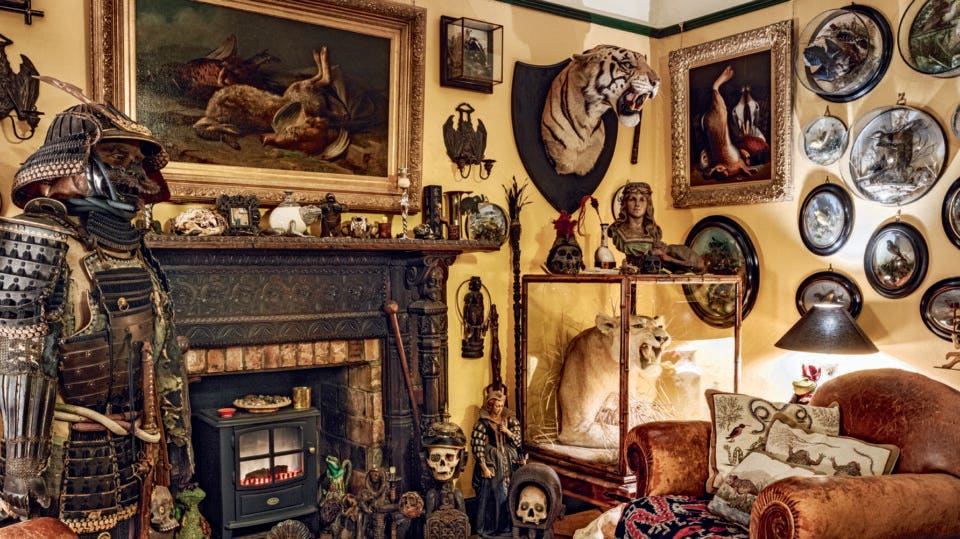1. Opt for the Real Thing
The modern Gothic style is all about authenticity and staying true to history. The good news is that you don’t need to spend much money to start your Gothic collection. While, for some pieces, authenticity may come with a high price tag, many other pieces are quite affordable. “There’s plenty of stuff true to the period out there,” says Gambino. Here are a few things he recommends collecting if you are a beginner or on a budget.
Photography and Books
Photo by Gianluca Santi and Lorenzo Vanzetti
We love how this homeowner chose to display their antique photos in a cabinet, creating a 3D art installation.
“I would suggest that if you don’t have anything, the first way to go is through photography. Victorian photography is fantastic,” says Gambino. Photos span many topics and themes, from family portraits and depictions of everyday life to the more morbid, post-mortem and mourning photography. Depending on where you look, you can pick up your first Victorian photo for as little as $5, says Gambino. Once you’ve acquired a few, consider framing and hanging them on a gallery wall with other photos and Gothic artifacts.
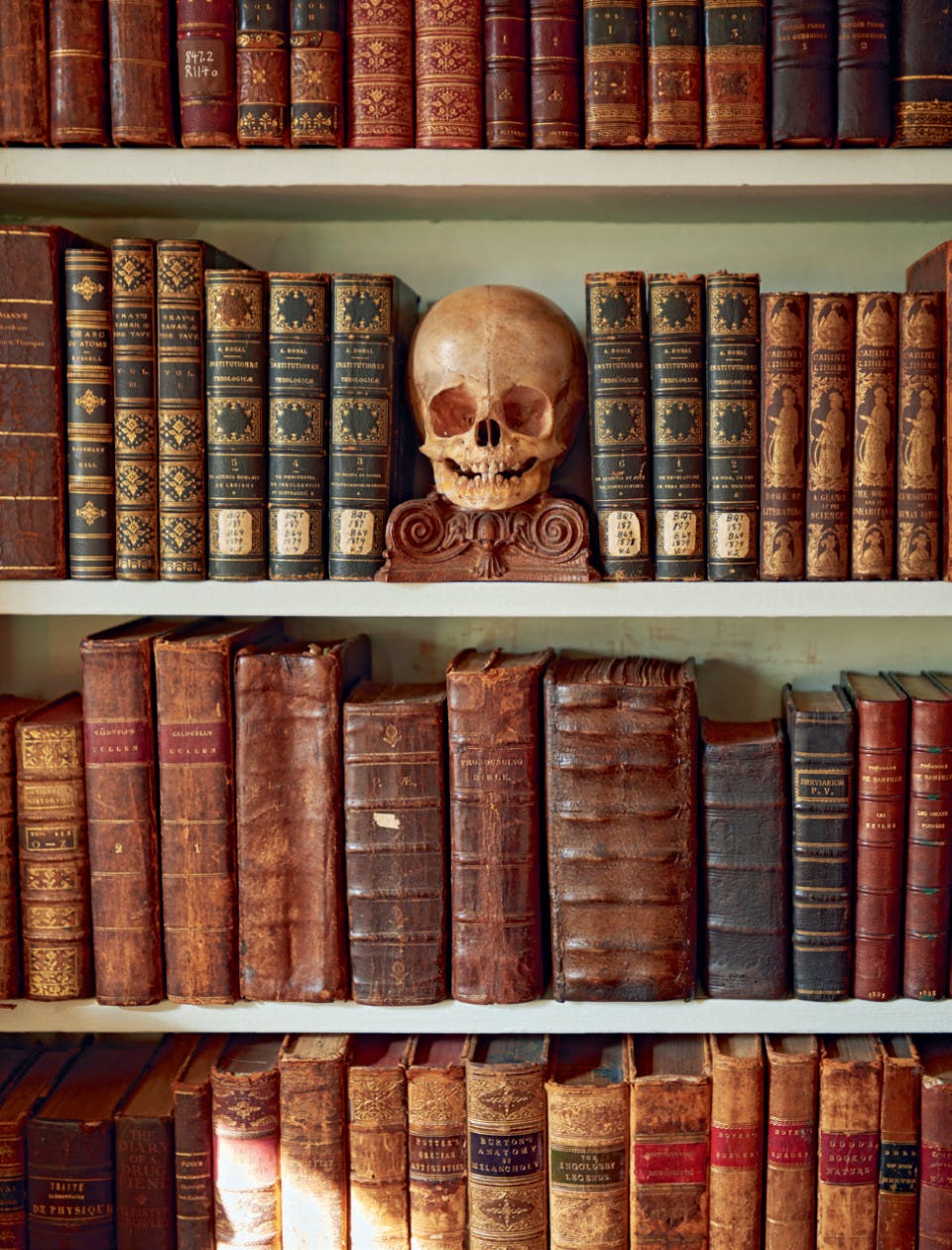
Photo by Dan Howell
This homeowner chose to display a variety of antique books. We love how they bring in subtle pops of color.
Another avenue into Victorian decor is through books. Go to an antique or even a thrift store and look at the book selection. You are bound to find some old ones at a reasonable price. Again, subjects will vary greatly, from school textbooks to novels to farming manuals. If you aren’t interested in reading the books, pick whichever has the best cover for optimal display. You’d be surprised at how beautiful even the most mundane vintage books are.
If you can’t find any books from the correct period but want to stay authentic, consider getting a few modern editions of classic Victorian novels like Dracula or The Picture of Dorian Gray. When you display them on your shelves, find copies bound in leather or other classic materials.
Osteology and Taxidermy
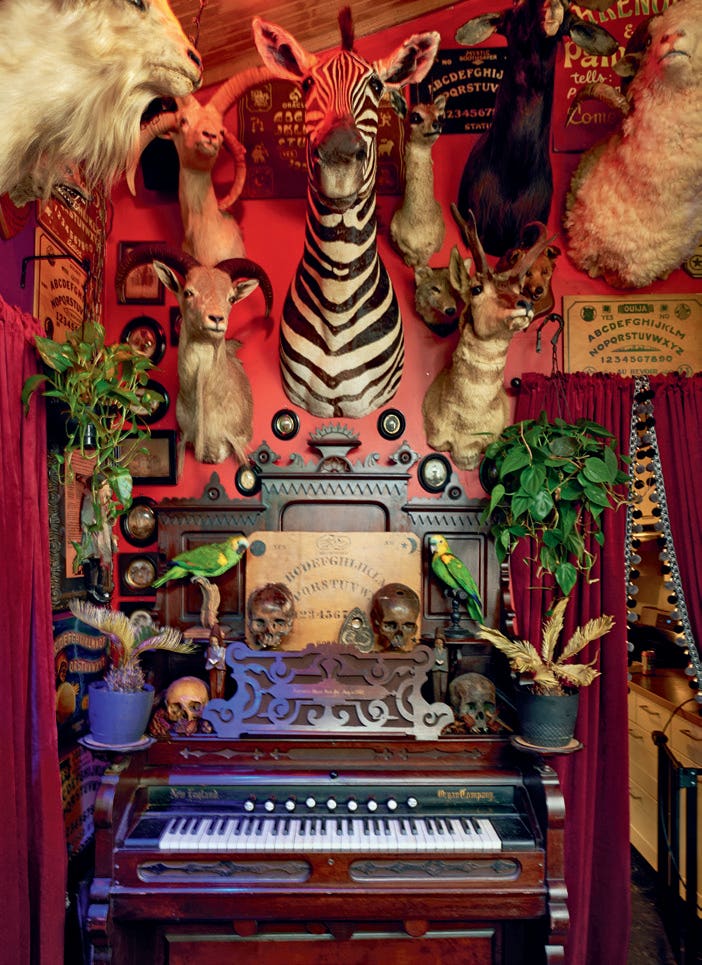
Photo by Dan Howell
This homeowner embraced both osteology and taxidermy in this bright red room.
If you want to take your Gothic decor a step further, consider collecting some osteology or taxidermy. Gambino says to start with a centerpiece. “You don’t have to have a lot,” he adds.
Taxidermy is another popular fixture in modern Gothic homes. Taxidermy ranges significantly in subject and price. Lower-priced options often include more common animals like deer, squirrels or foxes, while higher-priced subjects include more exotic, larger or rare species like bears, lions or giraffes.
Pro Tip
Always try to opt for ethically sourced taxidermy. To do this, enquire about the background of a specimen before purchasing it. Is it a vintage mount? Did the animal die a natural death? If it was hunted, was it legal, and were all the parts of the animal used? In a world where conservation is more important than ever, asking such questions is essential.
Victorian Furniture
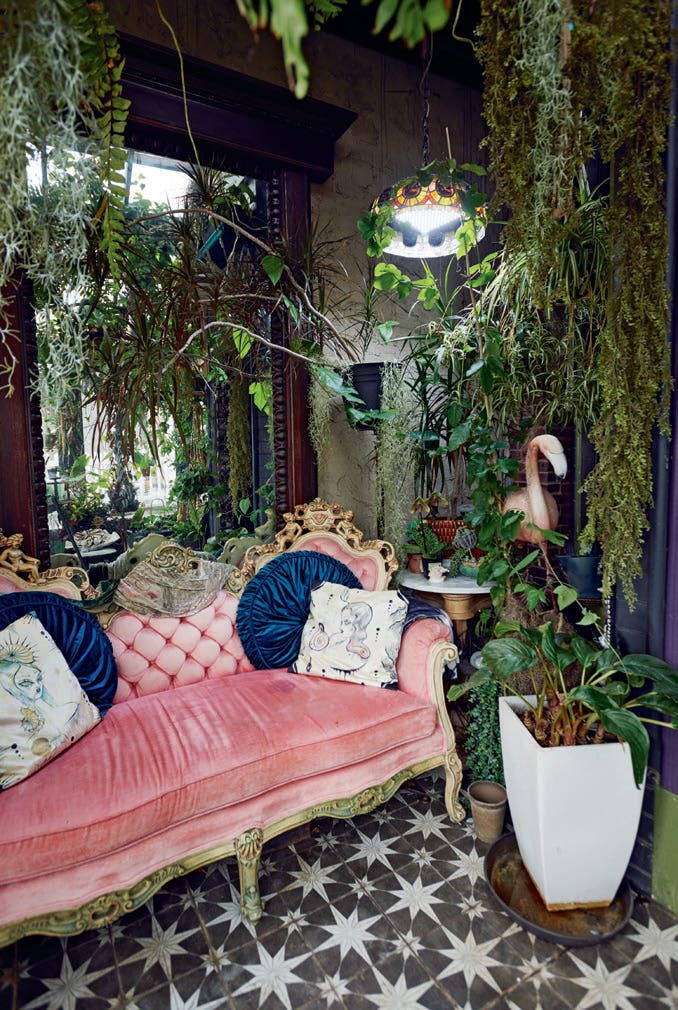
Photo by Dan Howell
We love the Victorian couch in this room. The pop of pink complements the otherwise dark color palette.
“[For] furniture… check the auctions. Victorian or Gothic furniture is so cheap if you’re willing to go pick it up,” says Gambino.
This is mainly because Victorian furniture is often large and ornate, making it heavy and difficult to transport. If your heart is set on a particularly large piece, consider hiring a specialty mover to help you get the article home.
It’s important to consider scale when looking at furniture, especially Victorian furniture. Some larger pieces like hutches, bookcases, desks or mantels might not fit or look right in a smaller space like an apartment. If you live in a small rental, you can still get Victorian furniture; you must be more intentional about your selection. Gambino says that fainting couches look especially eye-catching in apartments. But you should also consider beautifully carved side tables and wooden chairs.
2. Take Your Time
Have you ever heard the phrase, “It’s about the journey, not the destination?” Cheesy as it is, for many, that’s exactly what authentic Gothic interior design is all about. The process of collecting or the hunt is part of the fun. It gives the pieces even more meaning and stories to tell. And unless you have a huge budget, taking your time usually means spending less money.
“You don’t have to turn your home into a Gothic paradise overnight,” says Gambino. “It’s much better to wait two years to furnish your house and spend $3,000 than to do it in six months and spend $15,000.”
3. Leave the City
Sometimes, the best finds are seemingly out in the middle of nowhere. Why? There’s much less competition to grab the good stuff out there than in a big city. This may not always work if you are searching for a good deal, but generally try to avoid looking in large cities and college towns, advises Gambino.
“It’s worth it to take a road trip if you have a Saturday, a Sunday or if you’re off during the week (which is even better),” says Gambino. But be sure to map out your stops and plan ahead so you can visit as many places as possible. Consider visiting antique stores, rummage sales, auctions, estate sales, thrift stores or flea markets.
Pro Tip
When visiting flea markets, in particular, Gambino recommends visiting the booths that don’t specialize in the type of item you are searching for. These are the places where you’ll likely get the best deal on the items you want as long as you’re willing to hunt for them.
4. Curate Your Collection
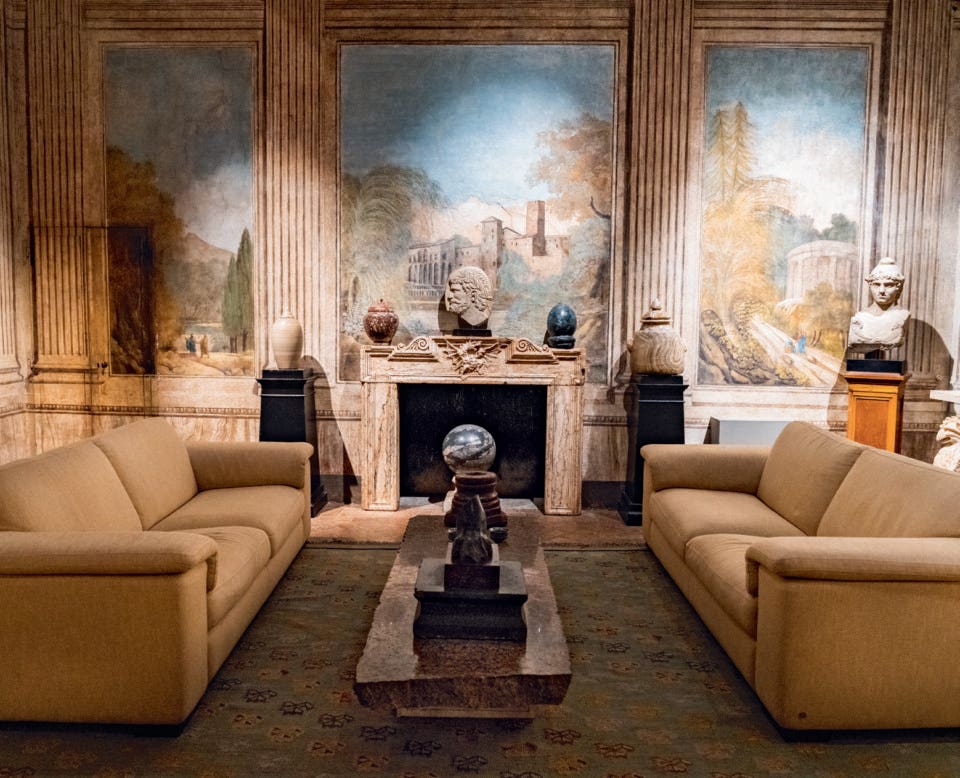
Photo by Gianluca Santi and Lorenzo Vanzetti
Here is an example of a more paired-down Modern Gothic home. It proves that you can embrace a more minimalistic and modern look while still being Gothic.
Hunting for and buying your Gothic decor is only part of the process. For most collectors, there comes a time when it’s necessary to edit the collection. When editing, consider which objects you look at and love the most. These are the ones you should keep. There are also likely forgotten objects tucked away in a drawer or the back of a closet. These are the ones to get rid of.
While it can be challenging to part with pieces of your collection, if you edit consistently, it’s possible to find joy in the task, says Gambino. To help you get through your next edit, consider three of the biggest benefits:
- It frees up space for new items.
- If you sell the item, you can sometimes make money.
- Your item can go to someone who’ll love it even more.
5. Find Your Inner Design Voice
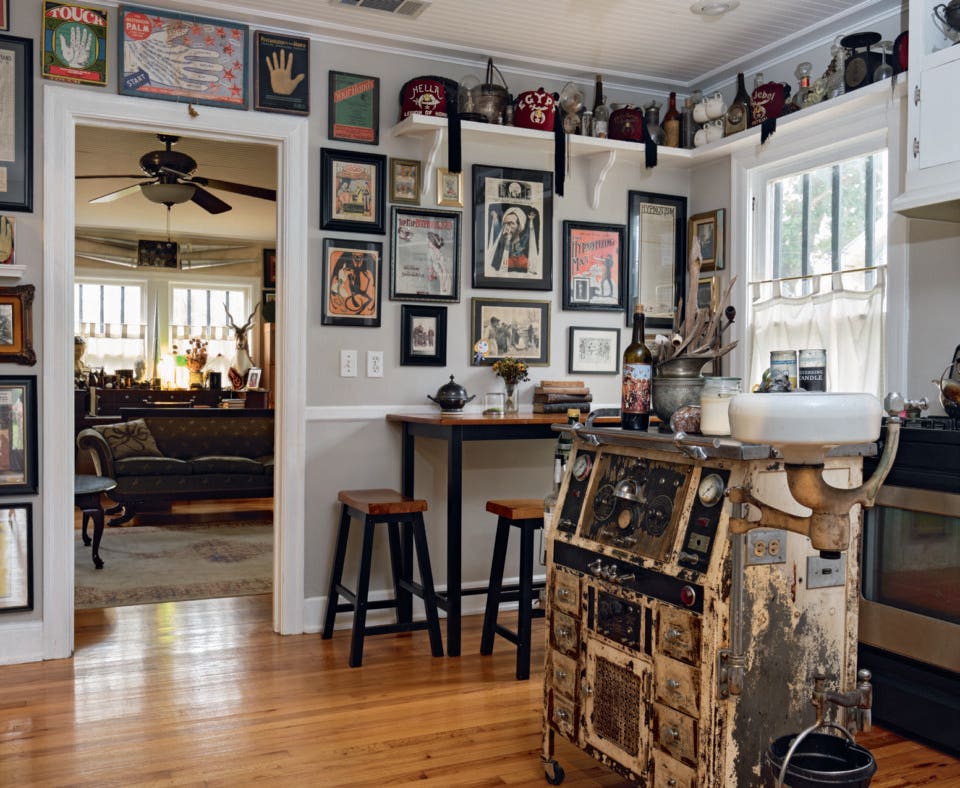
Photo by Erica Payne
We love how this homeowner found a way to incorporate the Gothic pieces they love into a modern-styled home, proving that two very different styles can still go well together.
The way you decorate your space reflects who you are or wish to be. Identifying the decor and styles you truly love is an important step in designing a Gothic home–or really any home.
“Think about the things you already love to do, what music you listen to, what you always gravitate towards. There is a design style for that. That’s your inner voice,” says Gambino.
If you are still unsure what style fits you, note what inspires you when you’re out and about. Maybe a particular painting draws you in at the art museum, or perhaps you love the tin ceiling of that new restaurant. Take pictures of these things, and eventually, you’ll find a common design thread you can utilize in your space.
If you like some aspects of modern Gothic style but also gravitate towards a completely different design, that’s okay. You’ll see in the book that each person’s interpretation of modern Gothic living is very different. “As long as you are true to the Gothic sensibility of your decor, incorporating some other element doesn’t take away from it being Gothic,” says Gambino.
Pro Tip
Don’t be afraid to add some color to your design. While the traditional black and red Gothic color palette is great, if your style leans a bit more colorful, embrace it. There are lots of homes in the book that adopt colorful palettes while remaining authentically Gothic.
Compare Quotes From Top-rated Interior Decorators
Free, No-commitment Estimates

